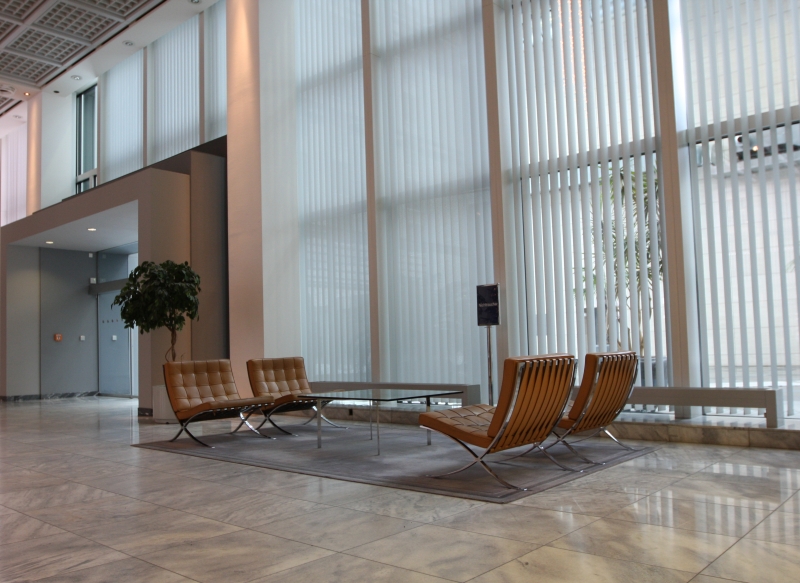(smow) blog Design Calendar: May 19th 1929 – Barcelona International Exposition Opens. Barcelona Chair Premiered.
“The design is not the result of any especially deep consideration, but much more of random form finding through sketching.”1 So remembers German architect and designer Sergius Ruegenberg the creation of the so-called Barcelona Chair; a chair that made its formal début with the opening of the Barcelona International Exposition on May 19th 1929.
Barcelona Chair? Sergius Ruegenberg?
Yes. Barcelona Chair. Sergius Ruegenberg.
Born in St. Petersburg in 1903 Sergius Ruegenberg trained as a structural engineer in Berlin before joining the office of architect Bruno Paul where he received a more detailed architectural training. From 1925 until 1934 Sergius Ruegenberg worked in the office of Ludwig Mies van der Rohe, assisting on numerous key projects of the period including the Villa Tugendhat in Brno and the German Pavilion for the 1929 Barcelona Exposition.
Although it is fair to say that initially no great furnishings were planned for the pavilion, the fact that King Alfonso XIII and Queen consort Victoria were due to visit the German Pavilion during the Exposition’s opening led Mies van der Rohe to decide that representative lounge chairs for the royal pair were required. Mies van der Rohe himself had previously developed a stool with an X-shaped bent steel base; Sergius Ruegenberg’s job was to develop a lounge chair from this stool.2
Unsure where to begin, or indeed how best to form an anatomically optimised lounge chair, Sergius Ruegenberg took himself of to the shores of Berlin’s Lake Wannsee where he sat himself in the sand to create an impression of an ideal sitting position, an impression into which he then pressed pliable steel wire. The resulting model formed the basis of his sketches.3
Which is one those design process stories that wonderfully illustrate just how much work, innovation and lateral thinking is involved in creating simple, reduced design.
In addition to sketching numerous alternative seat forms Sergius Ruegenberg also adapted and adjusted the form, depth and length of Mies van der Rohe’s original X-base to better fit his seat forms. According to Ruegenberg Mies van der Rohe asked him to complete his sketches on transparent paper so that he could more easily compare and contrast the differing versions4 before ultimately deciding which version, or which adaptation of which version, should be produced. Or as Ruegenberg phrases it, “I drew and Mies made the selection”.5
A statement which of course not only reminds us of the product development process at Hermann Miller under George Nelson’s reign, but of the general truth that more often than not several people work on creating a piece of furniture which ultimately is credited to only one, marketable, designer.
Which of course reminds us that it would be very nice if all involved were always given due credit.
Asked by Martin Gärtner why he had invested so much effort in the object when, ultimately, all that was needed was a representative chair where the Monarchs could briefly sit, Sergius Ruegenberg states, unequivocally, that Mies van der Rohe wanted to create a chair6, the exposition and the pavilion merely providing the opportunity.
Yet although a chair was wanted, for Mies van der Rohe it was wanted as an object for use in his architectural projects rather than as a commercial product. The first versions of the chair were made to order, as and when required, by metal fabricator Joseph Müller in Berlin and although in 1931 it entered a very brief period of commercial production as the MR 90 through the Bamberg Metallwerkstätten, Berlin, it famously took a lot of gentle persuasion from Florence Knoll in the 1950s before Mies van der Rohe finally allowed Knoll Associates to bring the Barcelona Chair into serial production.
Thankfully, for the inevitable ravages of war and unrest means that the vast majority of MR 90s produced in the 1930s no longer exist and so without Florence Knoll’s persistence one of the more charming moments of the 1929 Barcelona International Exposition and one of the most luxurious and sumptuous objects of European modernist furniture design would have been little more than a few sketches on transparent paper. And a Sergius Ruegenberg shaped dent somewhere on Wannsee beach.
1. Martin Gärtner, “Sergius Ruegenberg : eine Monographie ; Bauten und Entwürfe zur Berliner Architektur seit 1925”, Mann Verlag Berlin, 1990
2. ibid.
3. Eva-Maria Amberger, “Sergius Ruegenberg: Architekt zwischen Mies van der Rohe und Hans Scharoun”, Berlinische Galerie, 2000
4. Martin Gärtner, “Sergius Ruegenberg : eine Monographie ; Bauten und Entwürfe zur Berliner Architektur seit 1925”, Mann Verlag Berlin, 1990
5. Eva-Maria Amberger, “Sergius Ruegenberg: Architekt zwischen Mies van der Rohe und Hans Scharoun”, Berlinische Galerie, 2000
6. Martin Gärtner, “Sergius Ruegenberg : eine Monographie ; Bauten und Entwürfe zur Berliner Architektur seit 1925”, Mann Verlag Berlin, 1990
Tagged with: Barcelona Chair, Mies van der Rohe
